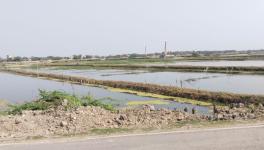Rising Drinking Water Salinity Affecting Health, Livelihoods in Sunderbans Region
Kolkata: The salinity level in drinking water is rising in Sundarbans area, posing a grave threat to not just the ecology but also the health and livelihoods of villagers living in the vicinity.
The rising salinity level has been flagged by a recent study by Washington-based Earth Journalism Network, comprising 12,000 environment journalists across the world
As per the sample study, some blocks in North 24 Parganas are heavily affected by water salinity. The pH (power of hydrogen -- a measure of the acid–base equilibrium) level in water of some areas in South 24 Parganas also indicated the risk of aggravating severe anthropogenic activities. In North 24 Parganas, some blocks are already coping with the effect of heavy TDS(total dissolved solids) level in water.
TDS is determined for measuring the amount of solid materials dissolved in the water. High TDS values have a harmful effect on the central nervous system of people, leading to paralysis of the tongue, lips, and face, irritability and dizziness. The presence of synthetic organic chemicals, even in small concentration, can generate an offensive taste, odour and colour in fish and aquatic plants. The report also found the presence of iron and heavy metals in the water.
NewsClick spoke with the principal investigator of the study, Aparajito Bandyopadhya, who had visited the Sandeshkhali block and Sagar Islands to conduct the study and witnessed the day-to-day miseries of the people living there as well as the scarcity of salinity-free safe drinking water in Sundarbans.
According to him, the range of TDS in the area falls between 500–1500 mg/L−1, while the average TDS in drinking water, as prescribed by the US EPA (1997), Indian Council of Medical Research, World Health Organisation and Bureau of Indian Standards is 300-500 mg/L.
Salinity is measured in milligram/litre unit in a laboratory. The acceptable limit of ground drinking water is 250 milligram per litre, which equals the specific gravity of distilled water (1.000) at 20 degree Celsius temperature.
In all blocks of Sundarbans region, the salinity in drinking water is much higher than the desired limit. No block reported a level below the 300mg/L, as a result of which people in the area are facing several ailments related to constant saline exposure.
The blocks in North and South 24 Parganas have been known for arsenic- contaminated groundwater and much work has been done to tackle the problem, but salinity has not been taken as seriously by government till now.
As far as livelihoods are concerned, agriculture is one of the worst victims of rising water salinity with the buffer zone created by paddy fields and mangroves also facing erosion.
“At just under 6 to 8 feet ground level, yellowish white water has been oozing out, which is excessively saline. As a result, in Sundarbans we have now nearly stopped construction of shallow tubewells,” said Prangopal Biswas of Shambhunagar gram panchayat, bordering the Basanti Assembly segment .
Meanwhile, cases of skin ailments and other health issues by people exposed to salinity in the Sundarbans region are being widely reported now.
According to Saroj Tarafdar, a medical practitioner, people have been reporting rashes, skin irritation and discolouration in body parts exposed to the saline alkaline ground water while working in farmlands.
The study also found in South 24 Parganas area of Sundarbans,
women were “facing high blood pressure, diabetes and thyroid problems.”
It cited on Dr. Ajay Patra of Sagar block who said that in the past five to 10 years, endocrinological disorders such diabetic metitus and thyroid problems among women have gone up.
In the earlier days, these problems were not there, said Gour Sarkar, a pisciculturalist in Kalidaspur gram panchayat of Gosaba block , who is now over 70 years old and takes turn to go to deep into the forest near the confluence of Chamta river, to collect crabs . Sarkar is also a mass singer whose songs on Bononbobir Pala are popular with households in the Sundrabans.
Excessive salinity is also affecting flora and fauna in the area. For instance, salt is considered bad for the Royal Bengal Tiger. While the average weight of an adult Royal Bengal tiger in other parts of India is over 180 kilogram, in the Sunderban region this has fallen to around 110 kg and even lower in some cases.
Some local residents also suspect that crocodile and tiger attacks are growing due to excessive water salinity which could be making them more irritable, such as in Dayapur , Kumirmari , and Kalidaspur gram panchayats. Three people even lost their lives after the attacks, some local residents told NewsClick.
The study points out that the district public health engineering laboratory was monitoring the drinking water parameter sin the 13 blocks in Sunderbans, the surveillance was still poor.
Get the latest reports & analysis with people's perspective on Protests, movements & deep analytical videos, discussions of the current affairs in your Telegram app. Subscribe to NewsClick's Telegram channel & get Real-Time updates on stories, as they get published on our website.















